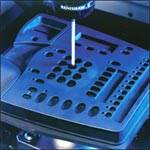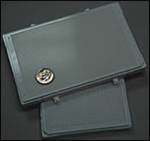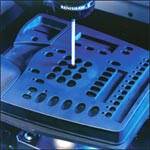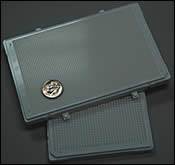Solutions for Your Large Mold Machining Challenges
The technology exists to successfully tackle large molds, as long as you acknowledge the problems associated with large mold machining and the machine design features that offer solutions.
The demand for large, highly cosmetic molds is growing rapidly. From flat-screen TVs to automobile dashboards, designers are pushing the size and complexity of molds. Given this fact, large mold manufacturing is an area where many shops are finding opportunity to compete globally.
So why isn’t everyone producing large molds? There are many barriers to entry, the most significant of which is the assumption that large molds are very difficult to machine. Old technology leads to long cycle times, slow feedrates, many setups and hours of hand polishing. However, high-performance machining technology can make large mold machining more like small mold machining.
Large Molds Have Issues
Dealing with the sheer size and weight of a large mold can be a big challenge. This often leads to excessive labor, the need for special equipment, multiple setups and potential inaccuracies.
If the proper machining center is chosen for the manufacture of large molds, many of these problems can be reduced or eliminated, easing setup, change-over and other potential accuracy issues.
The biggest expense often associated with the manufacture of large molds is machinery cost. Machines capable of producing big molds are expensive, so having multiple machines, one for roughing and another for finishing, for example, is a large barrier to entry for this market. When the proper machine is chosen, it is capable of roughing and finishing, even in the same setup and without losing accuracy.
Machine Designs for Large Molds
To counter common accuracy and setup concerns in large machines, we must look at some of the necessary design characteristics of a large mold machining center.
Cast Iron Construction and Spindle Capable of Dealing with Heat
The first thing any machine designed to mill large parts needs is a massive, cast iron construction and a spindle capable of dealing with heat. Cast iron is still the most stable material for machine construction, adding rigidity and heat-sink characteristics to the machine.
As far as the spindle is concerned, it must have internal technology built to cool the spindle from the bearings out, ensuring that the spindle is not going to burn itself out or lose accuracy with thermal expansion.
These items are important because large molds spend much longer in the cut than smaller ones, adding to the concerns of stress on the mold and heat. Without a well-built foundation, no machine tool will produce quality large molds due to these two factors. Vibration must be limited and heat must be dealt with.
Most large molds will be machined for days, meaning outside conditions will change as the part is machined, and those changes must be taken into account to achieve the necessary accuracies. In a machine not designed for the cutting conditions of a large mold, a 10oC environment temperature change results in a six-degree machine column temperature change, causing a spindle-angle plate parallelism change of 0.070mm.
Thermal Stabilization Technology
On the other hand, with a machine utilizing thermal stabilization technology, the same environment change results in a three-degree column temperature change, or a 0.030mm spindle-angle plate parallelism change. Therefore, machine design must also be conscious of environmental thermal effects, shielding outside air influences from affecting the part. If the machine you choose is thermally stable, it will also reduce blend-line problems; and, therefore reduce the need to hand polish the part.
Speed
A second machine feature to consider is speed. The spindle should run at least 20,000 rpm and metal removal rates should be at least 30 ipm. For example, there is a large mold machining center with rapid traverse and cutting feedrates of 787 ipm.
Accuracy
Accuracy is important in large molds if you plan to finish and rough on the same machine. The machining center you choose should be capable of similar positioning accuracies and repeatability of smaller machines.
Use a large mold machining center with a positioning accuracy of ±0.000060 inches (±0.0015 mm) and repeatability of ± 0.000040 inches (±0.001 mm). Also keep in mind that pitch accuracy is important, and should be kept within about 5 microns.
Feedback Resolution
To measure just how accurate you are machining, you must be aware of the machine’s feedback resolution. With a standard one micron feedback resolution, imperfections are common. When you get down to a 0.050 micron feedback resolution, the finish is nearly flawless. Control resolution, scale feedback and fine pitch ball screws all allow for this improved surface finish.
Spindle
Another machine design consideration is the spindle. The spindle on a large mold machine should be capable of predictable roughing, semi-finishing and high-quality finishing. As a benchmark, surface finishes should be able to get to around 2 microns. Tight finishing characteristics are especially important in shut-off and parting lines, where many moldmakers are forced to hand polish to make up for the inaccuracies of their tools. Also, because large machines are much more expensive, buying multiple machines for these three tasks is impractical.
In addition, the spindle must be designed to maximize tool life over extended machining periods by providing minimal vibration and growth. For example, when running a large fascia mold on a large mold machining center, you are able to obtain more than 30 hours of life with a 16mm CBN insert finish tool running at 314 ipm and achieving a surface finish of 0.336 micron Ra, 3.02 micron Rmax. Tooling costs add up quickly when machining a large mold, and having a machine designed to maximize tool life can save thousands of dollars per mold in tooling costs.
Movable, Multi-Axis Head
A desirable feature for the machining of especially complex large molds is a movable, multi-axis head. A variable geometry head design allows for simultaneous three-axis machining, capable of milling deep mold cavities and cooling holes, as well as many other cut combinations in the same setup. Because the size and weight of the workpiece translates into long setup times, reducing setups with three-axis capabilities without losing accuracy can go a long way to improving the ability for a shop to machine large molds. In addition, a multi-axis head will allow for slanted-hole machining, accomplished by tilting the spindle at an optimum angle for improved access to the milling point.
A multi-axis head also allows for the use of shorter tools. A shorter tool is always a more rigid, accurate tool, and prevents the spindle and the tool from colliding with the table. Finally, a multi-axis head allows for improved surface finish by using the radius edge instead of the tip of the tool.
Chip Management
Chip management becomes a serious issue of concern with large molds. On some large mold machining centers eighteen outlet holes are provided below the table of the machine to reliably catch chips, regardless of the table position. Four built-in hinge-type chip conveyors evacuate chips at high speed toward the front of the machine. The bed and column are protected by covers to prevent any freshly cut hot chips and coolant from direct contact with the machine’s cast-iron surfaces. The areas around the column and the bed as well as underneath the bed are insulated to eliminate thermal changes in the cast-iron machine structure caused by variation in the shop temperature.
Without an effective chip management system, no large mold machine will be able to operate without break-downs or thermal issues.
High Pressure Coolant Capabilities
A final feature that is important when choosing a large mold machine is high pressure coolant capabilities. For example, when drilling angled holes with a 2+3 machining approach, 1000psi coolant will allow for effective chip evacuation and more accurate cuts. Without the high pressure coolant, the tool will often block the chips from leaving the hole, causing chips to be re-cut. Having the ability to effectively machine angled holes will eliminate setup time and additional machinery needed for gun drilling, as is typically done for these types of cuts.
Large Mold Examples
Circle, Diamond and Square
Purpose of the detail is to the show the machine cutting simplified geometry in multiple locations. The parts are then measured to highlight the machine construction which allows accuracy to be performed in many locations.
• Toolpathing was kept to a simplified circle routine (G02 and G03) common in all machine controls. This allows the machine to perform to its core of accuracy without any influences from programming software.
This also showcases the machine ability to cut accurately using multiple feedrates.
• Typically machines were limited to one feedrate that would cut to accuracy.
• Backlash and compensation were all set to maximize one feedrate, typically the feedrate that would be used the most. As one can imagine if another feedrate was utilized inaccuracy would quickly appear.
Angled Drilling Holes Sample
Purpose of this detail is to the showcase the 2+3 stiffness as it relates to drilling large holes.
• A standard, off the shelf high speed steel drill was used to produce the hole in the material. Typically customers will not want to spend the difference in dollars when it comes to buying large carbide drills. Carbide drills in this size are expensive.
• High-speed drills don’t perform to the level of carbide but are common in many shops. This head was able to produce a hole using standard approaches with large drills.
IP/Fascia Sample
This detail was provided as a test of the machining ability of a large mold machining center. The purpose of the test is to machine a large IP/fascia in one setup using all the capabilities of the head to tilt and tip while still being able to rough the block from solid. One setup, one machine.
• Typically a part of this size would be roughed, semi-finished and finished as much as possible in a three-axis machine. A multi-axis machine would be used to do areas that tooling length could be reduced by tipping the tool. The reason for not doing all the work in the multi-axis machine is because of rigidity of construction and the inability of this machine to rough. Simply, some multi-axis machines are capable of finishing only.
• The determining factors for removing the detail and placing it on a multi axis machine will vary from part to part. However one reason seems to be constant in all cases. The geometry gets to smaller diameters where the combination of higher spindle speeds and shorter tooling need to be used.
- The detail would be removed from one machine and placed onto a multi-axis machine to finish difficult areas.
- This would account for only about 5 to 10 percent of the total machining time.
- Part processing time goes up significantly once this part is removed from a three-axis machine to a multi-axis machine.
Conclusion
The technology exists to successfully tackle the large molds of today and tomorrow, as long as you keep in mind the problems associated with large mold machining and the machine design features that counter those issues, large molds can be machined much like small molds.
Read Next
How to Select and Use Your Vertical Machining Center
Competitive shops need to consider the true capabilities of their VMCs to achieve a high level of accuracy and surface finish.
Read MoreMachining/EDM Combo Packs a Powerful Punch
This moldmaker’s new machining center and EDM offer versatility with the ability to machine a number of materials and EDM small holes with ease.
Read MoreHow to Use Strategic Planning Tools, Data to Manage the Human Side of Business
Q&A with Marion Wells, MMT EAB member and founder of Human Asset Management.
Read More


















.png;maxWidth=300;quality=90)




.jpg;maxWidth=300;quality=90)



